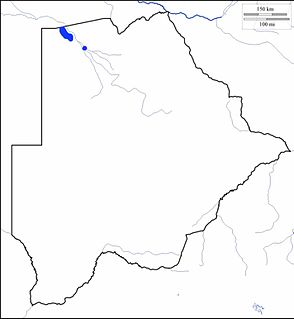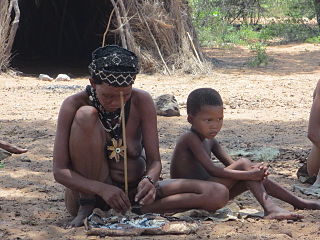Click consonants, or clicks, are speech sounds that occur as consonants in many languages of Southern Africa and in three languages of East Africa. Examples familiar to English-speakers are the Tut-tut or Tsk! Tsk! used to express disapproval or pity, the tchick! used to spur on a horse, and the clip-clop! sound children make with their tongue to imitate a horse trotting.

The Khoisan languages are a group of African languages originally classified together by Joseph Greenberg. Khoisan languages share click consonants and do not belong to other African language families. For much of the 20th century, they were thought to be genealogically related to each other, but this is no longer accepted. They are now held to comprise three distinct language families and two language isolates.

Taa, also known as ǃXóõ, is a Tuu language notable for its large number of phonemes, perhaps the largest in the world. Most speakers live in Botswana, but a few hundred live in Namibia. The people call themselves ǃXoon or ʼNǀohan, depending on the dialect they speak. The Tuu languages are one of the three traditional language families that make up the Khoisan languages.
Nǁng or Nǁŋǃke, commonly known by the name of its dialect Nǀuu (Nǀhuki), is a moribund Tuu (Khoisan) language once spoken in South Africa. It is no longer spoken on a daily basis, as the speakers live in different villages. The dialect name ǂKhomani is used for the entire people by the South African government, but the descendents of ǂKhomani-dialect speakers now speak Khoikhoi. As of January 2013, only three speakers of the Nǀuu dialect and two of the ǁʼAu dialect remain.
The palatal or palato-alveolar clicks are a family of click consonants found, as components of words, only in Africa. The tongue is nearly flat, and is pulled back rather than down as in the postalveolar clicks, making a sharper sound than those consonants. The tongue makes an extremely broad contact across the roof of the mouth, making a determination of their place of articulation difficult, but Ladefoged & Traill (1984:18) find that the primary place of articulation is the palate, and say that "there is no doubt that should be described as a palatal sound".
ǂʼAmkoe, formerly called by the dialectal name ǂHoan, is a severely endangered Kxʼa language of Botswana. West ǂʼAmkoe, Taa, and Gǀui form the core of the Kalahari Basin sprachbund, and share a number of characteristic features, including some of the largest consonant inventories in the world. ǂʼAmkoe was shown to be related to the Juu languages by Honken and Heine (2010), and as a result was classified along with the !Kung language in the Kxʼa language group.
ǀXam is an extinct Khoisan language of South Africa formerly spoken by the ǀXam-ka-ǃkʼe people of South Africa. It is part of the ǃUi branch of the Tuu languages and closely related to the moribund Nǁng language. Much of the scholarly work on ǀXam was performed by Wilhelm Bleek, a German linguist of the 19th century, who studied a variety of ǀXam spoken at Achterveld, and another spoken at Strandberg and Katkop while working with ǁKábbo, Diaǃkwāin, ǀAǃkúṅta, ǃKwéite̥n ta ǁKēn, ǀHaṅǂkassʼō and other speakers. The surviving corpus of ǀXam comes from the stories told by and vocabulary recorded from these individuals in the Bleek and Lloyd Collection.
Sekele is the northern variety of the !Kung dialect continuum. It was widespread in southern Angola before the civil war, but those varieties are now spoken principally among a diaspora in northern Namibia. There are also a number of dialects spoken in Northernmost Namibia.
ǂKxʼaoǁʼae, or Gobabi !Kung (Gobabis-!Xû), is a southeastern dialect of the ǃKung language, spoken in Botswana and in Namibia by about 7,000 people. In Botswana, most speakers are bilingual in Naro or Tswana.
Gǀui or Gǀwi is a Khoe dialect of Botswana with 2,500 speakers. It is part of the Gǁana dialect cluster, and is closely related to Naro. It has a number of loan words from ǂʼAmkoe. Gǀui, ǂʼAmkoe, and Taa form the core of the Kalahari Basin sprachbund, and share a number of characteristic features, including extremely large consonant inventories.

Khwe is a dialect continuum of the Khoe family of Namibia, Angola, Botswana, South Africa, and parts of Zambia, with some 8,000 speakers.
Tsoa or Tshwa, also known as Kua and Hiechware, is an East Kalahari Khoe dialect cluster spoken by several thousand people in Botswana and Zimbabwe.

Sandawe is a "click language" spoken by about 60,000 Sandawe people in the Dodoma region of Tanzania. Language use is vigorous among both adults and children, with people in some areas monolingual. Sandawe had generally been classified as a member of the defunct Khoisan family since Albert Drexel in the 1920s, due to the presence of clicks in the language. Recent investigations however suggest that Sandawe may be related to the Khoe family regardless of the validity of Khoisan as a whole. A discussion of Sandawe's linguistic classification can be found in Sands (1998).

The ǃKung are a part of the San people who live mostly on the western edge of the Kalahari desert, Ovamboland, and Botswana. The name "ǃKung" was given to the tribe by people outside its group. The ǃKung people call themselves the Juǀʼhoansi. In ǃKung society men and women live together in a non-exploitative manner, displaying a striking degree of equality between the sexes. This band level society used traditional methods of hunting and gathering for subsistence into the 1970s. Today, the great majority of ǃKung people live sedentary lives in the villages of Bantu pastoralists and European ranchers.
!Kung (!Xun), also known as Ju, is a dialect continuum spoken in Namibia, Botswana, and Angola by the ǃKung people, constituting two or three languages. Together with the ǂʼAmkoe language, !Kung forms the Kxʼa language family. !Kung constituted one of the branches of the putative Khoisan language family, and was called Northern Khoisan in that scenario, but the unity of Khoisan has never been demonstrated and is now regarded as spurious. Nonetheless, the anthropological term "Khoisan" has been retained as an umbrella term for click languages in general.

The Tuu languages, or Taa–ǃKwilanguages, are a language family consisting of two language clusters spoken in Botswana and South Africa. The relationship between the two clusters is not doubted but is not close. The name Tuu comes from a word for "person" common to both branches of the family.
The Khoe languages are the largest of the non-Bantu language families indigenous to southern Africa. They were once considered to be a branch of a Khoisan language family, and were known as Central Khoisan in that scenario. Though Khoisan is now rejected as a family, the name is retained as a term of convenience.
Ekoka !Kung or Western !Xuun is a variety of the !Kung dialect cluster, spoken originally in the area of the central Namibian–Angolan border, west of the Okavango River, but since the Angolan Civil War also in South Africa.
Central !Kung, or Central Ju, is a recently distinguished variety of the !Kung dialect cluster, spoken in a small area of northern Namibia: Neitsas, in Grootfontein district, and Gaub, in Tsumeb district. It is frequently reported as Grootfontein !Xuun, as most work has been done in Grootfontein. A possibly identifying feature of Central !Kung is a distinct series of retroflex clicks. While Northern (Northwestern) and Southern (Southeastern) !Kung are not mutually intelligible, it is not yet clear to what extent Central !Kung is intermediate between them or intelligible with either.
The bilabial nasal click is a click consonant found in some of the languages of southern Africa. The symbol in the International Phonetic Alphabet that represents this sound is ⟨ʘ̃⟩ or ⟨ᵑʘ⟩.






